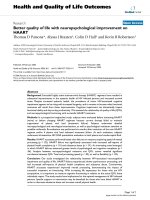predicting fatigue life with ansys
Bạn đang xem bản rút gọn của tài liệu. Xem và tải ngay bản đầy đủ của tài liệu tại đây (2.55 MB, 81 trang )
ANSYS, Inc. Proprietary
© 2006 ANSYS, Inc.
Predicting Fatigue Life with ANSYS
Workbench
How To Design Products That Meet Their Intended Design
Life Requirements
Predicting Fatigue Life with ANSYS
Workbench
How To Design Products That Meet Their Intended Design
Life Requirements
Raymond L. Browell, P. E.
Product Manager New Technologies
ANSYS, Inc.
Al Hancq
Development Engineer
ANSYS, Inc.
ANSYS, Inc. Proprietary
© 2006 ANSYS, Inc.
Fatigue Agenda
• General Fatigue Review
• Fatigue Analysis in Workbench
• Working with Legacy Models
• Optimization with Fatigue
• Fatigue Within Workbench Fits Into
Everyone’s Process!
• Questions and Answers
ANSYS, Inc. Proprietary
© 2006 ANSYS, Inc.
General Fatigue Review
• Why Fatigue Analysis?
– While many parts may work well initially,
they often fail in service due to fatigue
failure caused by repeated cyclic loading
– In practice, loads significantly below static
limits can cause failure if the load is
repeated sufficient times
– Characterizing the capability of a material
to survive the many cycles a component
may experience during its lifetime is the
aim of fatigue analysis
ANSYS, Inc. Proprietary
© 2006 ANSYS, Inc.
General Fatigue Review
• Common Decisions
for Fatigue Analysis
– Fatigue Analysis
Type
– Loading Type
– Mean Stress Effects
– Multiaxial Stress
Correction
– Fatigue Modification
Factor
Fatigue Analysis Type
Loading Type
Mean Stress Effects
Multiaxial Stress
Correction
Fatigue Modifications
ANSYS, Inc. Proprietary
© 2006 ANSYS, Inc.
General Fatigue Review
• Fatigue Analysis Types
– Strain Life
(Available in ANSYS Fatigue Module)
– Stress Life
(Available in ANSYS Fatigue Module)
– Fracture Mechanics
ANSYS, Inc. Proprietary
© 2006 ANSYS, Inc.
General Fatigue Review
• Strain Life
– Strain can be directly measured and has been shown to
be an excellent quantity for characterizing low-cycle
fatigue
– Strain Life is typically concerned with crack initiation
– In terms of cycles, Strain Life typically deals with a
relatively low number of cycles and therefore addresses
Low Cycle Fatigue (LCF), but works with high numbers
of cycles as well
– Low Cycle Fatigue usually refers to
fewer than 10
5
(100,000) cycles
– The Strain Life approach is widely used
at present
ANSYS, Inc. Proprietary
© 2006 ANSYS, Inc.
General Fatigue Review
• Strain Life
() ()
c
ff
b
f
f
NN
E
22
'
'
2
ε
σ
ε
+=
Δ
n
K
E
'
/1
'
2
⎟
⎟
⎠
⎞
⎜
⎜
⎝
⎛
+=
ΔΔ
Δ
σσ
ε
The Strain Life Relation equation
is shown below:
The two cyclic stress-strain parameters
are part of the equation below:
2
ε
Δ
σ
Δ
E
N
f
N
f
2
= Total Strain Amplitude
= 2 x the Stress Amplitude
= Modulus of Elasticity
= Number of Cycles to Failure
= Number of Reversals to Failure
σ
'
f
ε
'
f
K
'
n
'
= Fatigue Strength Coefficient
B = Fatigue Strength Exponent
(Basquin’s Exponent)
= Fatigue Ductility Coefficient
C = Fatigue Ductility Exponent
= Cyclic Strength Coefficient
= Cyclic Strain Hardening Exponent
ANSYS, Inc. Proprietary
© 2006 ANSYS, Inc.
General Fatigue Review
• Strain Life
– For Strain Life, the total strain (elastic +
plastic) is the required input
– But, running an FE analysis to determine
the total response can be very expensive
and wasteful, especially if the nominal
response of the structure is elastic
– So, an accepted approach is to assume a
nominally elastic response and then make
use of Neuber’s equation to relate local
stress/strain to nominal stress/strain at a
stress concentration location
ANSYS, Inc. Proprietary
© 2006 ANSYS, Inc.
General Fatigue Review
• Strain Life
Se
K
t
2
=
εσ
To relate strain to stress we use Neuber’s Rule, which is shown below:
ε
σ
K
t
e
S
= Local (Total) Strain
= Local Stress
= Elastic Stress Concentration Factor
= Nominal Elastic Strain
= Nominal Elastic Stress
ANSYS, Inc. Proprietary
© 2006 ANSYS, Inc.
General Fatigue Review
• Strain Life
– Simultaneously solving Neuber’s equation along
with cyclic strain equation, we can calculate the
local stress/strains (including plastic response)
given only elastic input
– Note that this calculation is nonlinear and is solved
via iterative methods
– ANSYS fatigue uses a value of 1 for K
t
, assuming
that the mesh is refined enough to capture any
stress concentration effects
• Note: This K
t
is not be confused with the Stress
Reduction Factor option which is typically used in Stress
life analysis to account for things such as reliability and
size effects
ANSYS, Inc. Proprietary
© 2006 ANSYS, Inc.
General Fatigue Review
• Stress Life
– Stress Life is based on S-N curves (Stress – Cycle
curves)
– Stress Life is concerned with total life and does not
distinguish between initiation and propagation
– In terms of cycles, Stress Life typically deals with a
relatively High number of cycles
– High number of cycles is usually refers to more than
10
5
(100,000) cycles
– Stress Life traditionally deals with
relatively high numbers of cycles and
therefore addresses High Cycle Fatigue
(HCF), greater than 10
5
cycles inclusive
of infinite life
ANSYS, Inc. Proprietary
© 2006 ANSYS, Inc.
General Fatigue Review
• Fracture Mechanics
– Fracture Mechanics starts with an assumed flaw of known
size and determines the crack’s growth
– Facture Mechanics is therefore sometimes referred to as
“Crack Life”
– Facture Mechanics is widely used to determine inspection
intervals. For a given inspection technique, the smallest
detectable flaw size is known. From this detectable flaw size
we can calculate the time required for the crack to grow to a
critical size. We can then determine our inspection interval
to be less than the crack growth time.
– Sometimes, Strain Life methods are used to determine crack
initiation with Fracture Mechanics used to determine the
crack life therefore:
Crack Initiation + Crack Life = Total Life
ANSYS, Inc. Proprietary
© 2006 ANSYS, Inc.
• ANSYS Fatigue Module
– Integrated into the ANSYS Workbench Environment
– ANSYS Fatigue Module is able to further leverage
advances that the ANSYS Workbench offers such as:
• CAD support including Bi-Directional Parameters
• Solid Modeling
• Virtual Topology
• Robust Meshing
• Hex-Dominant Meshing
• Automatic Contact Detection
• Optimization
• Design for Six Sigma
• Robust Design that the ANSYS Workbench offers
Fatigue Analysis in Workbench
ANSYS, Inc. Proprietary
© 2006 ANSYS, Inc.
Fatigue Analysis in Workbench
• Strain Life Decisions
for Fatigue Analysis
– Loading Type
– Mean Stress Effects
– Multiaxial Stress
Correction
– Fatigue Modification
Factor
ANSYS, Inc. Proprietary
© 2006 ANSYS, Inc.
Fatigue Analysis in Workbench
• Stress Life
Decisions for
Fatigue Analysis
– Loading Type
– Mean Stress Effects
– Multiaxial Stress
Correction
– Fatigue Modification
Factor
ANSYS, Inc. Proprietary
© 2006 ANSYS, Inc.
Fatigue Analysis in Workbench
• Loading Types
– Constant amplitude, proportional loading
– Constant amplitude, non-proportional
loading
– Non-constant amplitude, proportional
loading
– Non-constant amplitude, non-proportional
loading
ANSYS, Inc. Proprietary
© 2006 ANSYS, Inc.
Fatigue Analysis in Workbench
• Constant amplitude, proportional loading
– Loading is of constant amplitude because only
one set of FE stress results along with a
loading ratio is required to calculate the
alternating and mean values
ANSYS, Inc. Proprietary
© 2006 ANSYS, Inc.
Fatigue Analysis in Workbench
• Constant amplitude, proportional loading
– Is the classic, “back of the envelope”
calculation describing whether the load has a
constant maximum value or continually varies
with time
– The loading ratio is defined as the ratio of the
second load to the first load (LR = L2/L1)
– Common types of constant amplitude loading
are:
• Fully reversed (apply a load, then apply an equal
and opposite load; a load ratio of –1)
• Zero-based (apply a load then remove it; a load ratio
of 0)
ANSYS, Inc. Proprietary
© 2006 ANSYS, Inc.
Fatigue Analysis in Workbench
• Constant amplitude, proportional loading
– Loading is proportional since only one set of FE
results are needed (principal stress axes do not
change over time)
– Since loading is proportional, looking at a single
set of FE results can identify critical fatigue
locations.
– Since there are only two loadings, no cycle
counting or cumulative damage calculations
need to be done
ANSYS, Inc. Proprietary
© 2006 ANSYS, Inc.
Fatigue Analysis in Workbench
• Constant amplitude, non-proportional loading
– Looks at exactly two load cases that need not be
related by a scale factor
– Analyses where loading is proportional but results
are not
– The loading is of constant amplitude but non-
proportional since principal stress or strain axes
are free to change between the two load sets
– This happens under conditions where changing
the direction or magnitude of loads causes a
change in the relative stress distribution in the
model. This may be important in situations with
nonlinear contact, compression-only surfaces, or
bolt loads
ANSYS, Inc. Proprietary
© 2006 ANSYS, Inc.
Fatigue Analysis in Workbench
• Constant amplitude, non-proportional loading
– This type of fatigue loading can describe common
fatigue loadings such as:
• Alternating between two distinct load cases (like a
bending load and torsional load)
• Applying an alternating load superimposed on a static
load
– No cycle counting needs to be done
– But since the loading is non-proportional, the
critical fatigue location may occur at a spatial
location that is not easily identifiable by looking at
either of the base loading stress states
ANSYS, Inc. Proprietary
© 2006 ANSYS, Inc.
Fatigue Analysis in Workbench
– Fatigue tools located under a
solution branch are inherently
applied to that single branch
and thus can only handle
proportional loading
• In order to handle non-
proportional loading, the fatigue
tool must be able to span
multiple solutions
• This is accomplished by adding a
fatigue tool under the solution
combination folder that can
indeed span multiple solution
branches
• Constant amplitude, non-proportional loading
ANSYS, Inc. Proprietary
© 2006 ANSYS, Inc.
Fatigue Analysis in Workbench
• Non-constant amplitude, proportional loading
– Instead of using a single load ratio to calculate alternating and
mean values, the load ratio varies over time
– Think of this as coupling an FE analysis with strain-gauge results
collected over a given time interval
– Since loading is proportional, the critical fatigue location can be
found by looking at a single set of FE results
ANSYS, Inc. Proprietary
© 2006 ANSYS, Inc.
Fatigue Analysis in Workbench
• Non-constant amplitude,
proportional loading
– However, the fatigue loading
which causes the maximum
damage cannot easily be seen
– Thus, cumulative damage
calculations (including cycle
counting such as Rainflow and
damage summation such as
Miner’s rule) need to be done
to determine the total amount
of fatigue damage and which
cycle combinations cause that
damage
– Cycle counting is a means to
reduce a complex load history
into a number of events, which
can be compared to the
available constant amplitude
test data
ANSYS, Inc. Proprietary
© 2006 ANSYS, Inc.
Fatigue Analysis in Workbench
• Non-constant amplitude, proportional loading
– The ANSYS Fatigue Module uses a “quick
counting” technique to substantially reduce
runtime and memory
– In quick counting, alternating and mean stresses
are sorted into bins before partial damage is
calculated
– Without quick counting, data is not
sorted into bins until after partial
damages are found
– The accuracy of quick counting is
usually very good if a proper number
of bins are used when counting









